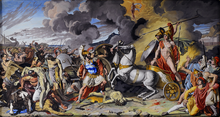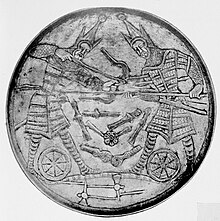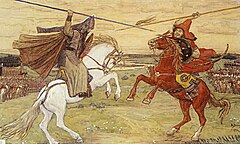Single combat

Single combatis aduelbetween two single combatants which takes place in the context of a battle between twoarmies.
Instances of single combat are known fromClassical Antiquityand theMiddle Ages.The champions were often combatants who represented larger, spectator groups. Such representative contests and stories thereof are known worldwide.
Typically, it takes place in theno-man's-landbetween the opposing armies, with other warriors watching and themselves refraining from fighting until one of the two single combatants has won. Often, it ischampion warfare,with the two considered the champions of their respective sides.
Single combat could also take place within a larger battle. Neitherancientnormedieval warfarealways relied on thelineorphalanx formation.TheIliadnotably describes the battles of the Trojan war as a series of single encounters on the field, and the medieval code ofchivalry,partly inspired by this, encouraged the single combat between individualknightson the battlefield, in which the loser was not usually killed but taken captive for ransom. However, the use of thelongbowand thepike squareagainst mounted knights (as at the battles ofCrécyandLaupen) ended this tradition in the 14th century, although it was continued away from the battlefield, with thepas d'armesand the early modern duel.
Antiquity
[edit]
An important episode in "The Tale of Sinuhe",one of the most well-known works ofAncient Egyptian literature,concerns the protagonist – an Egyptian exile in UpperRetjenu(Canaan) – defeating a powerful opponent in single combat.
Duels between individual warriors are depicted in theIliad,including those betweenMenelausandParisand later betweenAchillesandHector.TheHebrew Biblealso includes a few accounts of single combat, the most famous beingDavidversusGoliath.
Single combat is mentioned quite frequently in the history ofancient Rome–Romulusdefeated Acro, king of Caenina for thespolia opima;theHoratii's defeat of theAlba LonganCuriatii in the 7th century BC is reported byLivyto have settled a war in Rome's favor and subjected Alba Longa to Rome;Aulus Cornelius CossusdefeatedLars Tolumnius,king of theVeientesin single combat and took thespolia opima.In the 3rd century BC;Marcus Claudius Marcellustook thespolia opimafromViridomarus,king of theGaesatae,at theBattle of Clastidium(222 BC); andMarcus Licinius Crassusfrom Deldo, king of theBastarnae(29 BC).
Depictions of single combat also appear in the Hindu epics of theMahābhārataand theRamayana.Single combats are often preludes to battles in the Chinese epicRomance of the Three Kingdomsand are featured prominently throughout the epic.
Middle Ages
[edit]According to the Byzantine historiansNikephorosandTheophanes the Confessor,during theBattle of Nineveh- climactic battle of theByzantine–Sasanian War of 602–628- the Persian generalRhahzadhchallenged the Byzantine EmperorHeracliusto single combat with the hope of forcing the Romans to flee. Heraclius accepted the challenge and spurred his horse forward and with a single blow struck off Rhahzadh's head, taking from the dead Persian his shield of 120 gold plates and gold breastplate as trophies. With Rhahzadh's death perished the Persians' hopes of victory: seeing their brave commander and many other high-ranking officers being slain by Heraclius and his household troops, the Persian troops lost heart and were slaughtered suffering around 6,000 casualties.[2][3][4]
InThe Cattle Raid of Cooley,a famous episode ofIrish mythology,all the warriors ofUlsterbutCúchulainnare made sick by a curse and unable to fight the invading army of Queen Maeb, leaving Cúchulainn to fight a whole series of single combats by himself until they recover. TheWelsh mythological tale,theFourth Branchof theMabinogi,depicts a single combat between thesouthernprincePryderiand thenorthernmagician Gwydion, to determine the victor of a war between the two kingdoms.
Many battles depicted in the medievalChanson de Rolandconsist of a series of single combats, as are battles in the early Russianepic poemThe Tale of Igor's Campaign(the basis ofBorodin's OperaPrince Igor) and the battles depicted in various tales of theArabian Nights.
Guy of Warwick,the legendary EnglishRomancehero, is depicted as defeating in single combat theVikinggiantColbrand;the story is set in the time ofAthelstan of England,but actually reflects the society of the late Middle Ages.
An important episode inGeoffrey of Monmouth's legendaryHistory of the Kings of Britainis the single combat between princeNennius of BritainandJulius Caesar.
Single combat was also a prelude to battles in pre-IslamicArabiaand earlyIslamicbattles. For example, theBattle of Badr,one of the most important in theearly history of Islam,was opened by three champions of the Islamic side (Ali, Ubaydah, and Hamzah) stepping forward, engaging and defeating three of the then-PaganMeccans,although Ubaydah was mortally wounded.[5]This result of the three single combats was considered to have substantially contributed to the Muslim victory in the overall battle which followed. Duels were also part of other battles at the time ofMuhammad,such as thebattle of Uhud,battle of the Trenchand thebattle of Khaybar. In the early Muslim conquest the Muslim commander would often duel with the enemy commander, For example,Khalid ibn al-Walidand hormozd in the battle of the chains.
Single combats were characteristic of theSamuraifighting tradition and known asIkki-uchi.As each samurai commanded his unit of retainers, successfully challenging and defeating the opposing samurai by a single combat can force the entire unit to retreat minimizing casualties and changing the course of battle. Those seeking a suitable opponent, frequently usedNanorito issue a challenge by announcing his name and bravery as well as ridiculing opponents to boost morale of his side as well as enrage the opponent to force the combat. As this is a high-risk-low-return strategy for the winning side, already defeated side, or ill-matched opponent (difference of personal standing or martial reputation) it was acceptable to decline or elude the single combat. An example of single-combat with the tragic result for the victor is told inHeike MonogatariasKumagai NaozanedefeatedTaira no Atsumoriat theBattle of Ichi-no-Tani.It could be banned by the overall commander as needed and notably duringMongol invasions of Japan,particularly during the second invasion in 1281, samurai fought as massed mounted archer/warrior with the annihilation of enemy as the goal. This tradition declines and disappears during theSengoku periodas each side prepared trained armies in thousands or even tens of thousands making the single combat have a limited, if any, effect on the outcome of the battle.
In Russia, single combat is known asbash na bash(an old Russian expression meaning "one-on-one" ), substituting a fight between champions for a full-scale battle was a traditional way to avoid the bloodshed of an internecine war. The leaders of the opposingdruzhinasor other armed groups either rode towards the centre of the battlefield or sent messengers to negotiate whether the two most skilled fighters or the leaders themselves would engage in single combat, usually to the death. The outcome of the champions' fight would then be taken as a sign of which side the higher powers favoured, and could have political consequences similar to the result of a full battle.
The oldest written account of such a fight is found inNestor'sPrimary Chronicle;it describes a duel between aKievanchampion and the Pechenegs' best fighter. The most well-known fight, however, was that between PrinceMstislav the BraveofTmutarakanand theKasogPrinceRedediain 1022, in which Mstislav defeated Rededia and killed him with a dagger. According to thePrimary Chronicle,Mstislav's victory allowed him to take tribute from the Kasogs and to have a church built; he also took Rededia's wife and two sons and had them baptised into Christianity, upon which he had his daughter married to Rededia's son according to the tradition of the times. Although Rededia had been killed, he was honoured by Mstislav, and his family joined the ranks of theRussian nobility.
The semi-legendaryTale of the Destruction of Ryazanincludes an extensive account of the combat between the Russian heroEvpaty Kolovratand the Tatar warrior Hostovrul. Kolovrat splits his opponent in half with his sword and wins the duel. However, Kolovrat is then attacked and killed from a distance by Tatar stone throwers. The Mongol rulerBatu Khan,impressed with his bravery, honours his body.

Sometimes however, such single combat would merely initiate a battle rather than prevent it. The most famous example of this was the duel between Russian monkAlexander Peresvetand theGolden HordechampionChelubeyor Temir-Murza at the beginning of theBattle of Kulikovoin 1380. The champions killed each other in the first run, though according to Russianlegend,Peresvet did not fall from thesaddle,while Temir-Murza did.
InKerala,India, duelling between warriors was used to settle conflicts between local rulers. The prime martial caste of Kerala,Nairs,and some prominentEzhavafamilies made up theChekavars(which literally means "those who are prepared to die" in theMalayalamlanguage). Some prominent warriors who took part in suchankam(duels) wereThacholi Othenan,Unniarcha,Aromal Chekavar,whose legends are described in theVadukkan Pattukal(Northern Ballads). TheMamankamFestival held by theZamorinruler in the kingdom of modern-dayKozhikode,was a ritual which glorified the martial traditions of warrior families in theMalabar.The ritual ended after the Zamorin was overthrown. The Kerala practice was discontinued in the 19th century under theBritish Raj.
In Southeast Asia, formalelephant duelswere sometimes contested between opposing army leaders to determine the outcome of a conflict, in lieu of full-on fighting by their armies.[7]
Modern examples
[edit]CaptainJohn Smith of Jamestownis reputed in his earlier career as a mercenary in Eastern Europe to have defeated, killed and beheaded Turkish commanders in three single combats, for which he wasknightedby theTransylvanianPrinceSigismund Báthoryand given a horse andcoat of armsshowing three Turks' heads.[8]
DramatistBen Jonson,in conversations with the poetWilliam Drummond,recounted that when serving in theLow Countriesas a volunteer with the regiments ofFrancis Vere,he had defeated an opponent in single combat "in view of both armies" and stripped him of his weapons.[9]
In more recent times, single combats have become iconic – though often apocryphal – elements ofaerial dogfights,with the idea, if not the practice, of single combat in the skies particularly prevalent during theFirst World Warwith the air forces' emphasis on a sort of individualism and chivalry.Manfred von Richthofen,the infamous "Red Baron", is recorded as writing "If I am alone with an opponent... only a jammed gun or an engine problem can prevent me from shooting him down."[10]
See also
[edit]References
[edit]- ^Mode, M. (2006). Heroic fights and dying heroes. The Orlat battle plaque and the roots of Sogdian art. Ēran ud Anērān. Studies Presented to Boris Il’ič Maršak on the Occasion of His 70th Birthday (Venezia 2006), 419-454.
- ^Kaegi 2003,p. 167.
- ^Norwich 1997,p. 93
- ^Konieczny, Peter (June 5, 2016)."Single Combat? The Duel between Heraclius and Razhadh at the Battle of Nineveh".Karwansaray Publishers.RetrievedFebruary 5,2018.
- ^"Sunan Abu Dawud: Book 14, Number 2659".Usc.edu. Archived fromthe originalon 2011-02-10.Retrieved2010-05-30.
- ^Parppei, Kati M. J. (5 January 2017).The Battle of Kulikovo Refought: "The First National Feat".BRILL. p. 205.ISBN978-90-04-33794-7.
- ^Terwiel, Barend Jan (2013)."What Happened at Nong Sarai? Comparing Indigenous and European Sources for Late 16th Century Siam".Journal of the Siam Society.101:19–34.
- ^Not Just Another John Smith,usnews, January 21, 2007
- ^Drummond, William (1619).Heads of a conversation betwixt the famous poet Ben Johnson and William Drummond of Hawthornden, January 1619.
- ^Tucker, S.; Wood, L.M.; Murphy, J.D. (1999).The European Powers in the First World War: An Encyclopedia.Garland Pub. p. 11.ISBN9780815333517.Retrieved2014-10-18.
Bibliography
[edit]- Kaegi, Walter Emil(2003),Heraclius: emperor of Byzantium,Cambridge University Press,ISBN0-521-81459-6
- Norwich, John Julius(1997),A Short History of Byzantium,Vintage,ISBN978-0-679-77269-9
External links
[edit] Media related toSingle combatat Wikimedia Commons
Media related toSingle combatat Wikimedia Commons- Champions and Tradition: Single Combat in the Late Roman World
